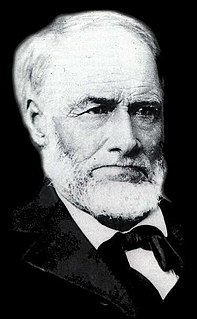
James Wilson Marshall was an American carpenter and sawmill operator, who reported the finding of gold at Coloma on the American River in California on January 24, 1848, the impetus for the California Gold Rush. The mill property was owned by Johann (John) Sutter who employed Marshall to build his mill. The wave of gold seekers turned everyone's attention away from the mill which eventually fell into disrepair and was never used as intended. Neither Marshall nor Sutter ever profited from the gold find.

The Reed Smoot House, also known as Mrs. Harlow E. Smoot House, was the home of Reed Smoot from 1892 to his death in 1941, and is located at 183 E. 100 South, Provo, Utah, United States. Smoot was a prominent US Senator best known for advocacy of protectionism and the Smoot–Hawley Tariff Act.

Bristol County Jail is a historic jail at 48 Court Street in Bristol, Rhode Island and home to the Bristol Historical and Preservation Society.

Thomas and Esther Smith House is a historic house at 251 North West Street in Agawam, Massachusetts. It is one of the oldest houses in Agawam. The house is situated on 1 acre (0.40 ha) of land about 5 miles (8.0 km) west of the Connecticut River, at the foot of Provin Mountain. It is a vernacular 1+1⁄2-story house with plain Georgian styling. The main block of the house is three bays wide, with a gambrel roof and a central chimney. A 1+1⁄2-story addition on the western side of the house as a gabled roof. The main block's foundation is fieldstone, while that of the addition is brick and concrete block.
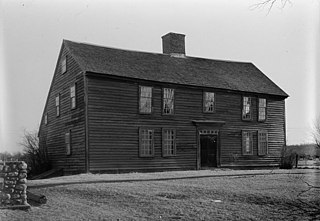
The Thomas Lee House is a historic house at the junction of Giant's Neck Road and Connecticut Route 156 in the Niantic section of East Lyme, Connecticut. Built about 1660, it is one of the oldest wood-frame houses in Connecticut. Restored in the early 20th century by Norman Isham, it is now maintained by the East Lyme Historical Society as a museum. It was listed on the National Register of Historic Places in 1970.

Norwichtown is a historic neighborhood in the city of Norwich, Connecticut. It is generally the area immediately north of the Yantic River between I-395 and Route 169.

The Henry J. Wheeler Farm is a farmstead in Murray, Utah, United States, that is one of the few remaining late 19th century farmsteads in the Salt Lake Valley that has not been lost to expanding housing developments of metropolitan Salt Lake City. It has been listed on the National Register of Historic Places since 1976.

The Newlin Mill Complex, also referred to as The Newlin Grist Mill, is a water-powered gristmill on the west branch of Chester Creek near Concordville, Pennsylvania was built in 1704 by Nathaniel and Mary Newlin and operated commercially until 1941. During its three centuries of operation, the mill has been known as the Lower Mill, the Markham Mill, the Seventeen-O-Four Mill and the Concord Flour Mill. In 1958 the mill property was bought by E. Mortimer Newlin, restored and given to the Nicholas Newlin Foundation to use as a historical park. Water power is still used to grind corn meal which is sold on site. The park includes five historical buildings, which were added to the National Register of Historic Places in 1983, and 150 acres (61 ha) of natural woodland.

The Avery Homestead is a two-story Colonial-style home in Ledyard, Connecticut that was built circa 1696. Evidence suggests that the house may have begun as a single-story, one-room house and later expanded to a two-story, two-room house by 1726. The house underwent major additions and renovations by Theophilus Avery and later his grandson, Theophilus Avery. In the mid-1950s, Amos Avery began a decade-long restoration effort to return the house to its 18th-century appearance. The Avery Homestead is historically significant as a well-preserved example of an 18th-century farmhouse with fine craftsmanship. The home is also historically important because more than twelve generations of the Avery family have resided there over the course of three centuries. The Avery Homestead was listed on the National Register of Historic Places in 1992.

The Brigham Young Winter Home and Office is a historic residence and museum located in St. George, Utah. Brigham Young was the foremost Mormon pioneer and second president of The Church of Jesus Christ of Latter-day Saints, who led its members to the Utah Territory. As Young grew older, his arthritis precluded him from spending winters in the Salt Lake City region, so a winter home in St. George, in the arid Dixie region of Utah, was built for him. Young seasonally occupied the home and office from 1873 to 1876. The building was eventually deeded to the division of Utah State Parks and Recreation; it is now open as a museum where missionaries of the Church provide guided tours.

The St. George Opera House, also known as the St. George Social Hall, is a historic building in St. George, Utah. It was originally built by the St. George Gardeners' Club as a wine cellar. As wine demand decreased, the building was expanded to host theatrical productions. It operated in this capacity until sold to the Utah-Idaho Sugar Company in 1936. It was restored to an opera house in 1988 and is again open to the public.

Graham-Brush Log House is a historic home located in the Town of Pine Plains, Dutchess County, New York. It was built in about 1776 and is a two-room log structure with a wood frame lean-to on its rear elevation. It measures roughly 39 feet long and 18 feet wide. It is one and one half stories with a gable roof; the lean-to addition is one story. The Brush house was acquired in 1997-1998 by the local historical society, the Little Nine Partners Historical Society. In 1998 it was damaged by an arson fire.

Headquarters House, also known as the Colonel Tebbetts place, is a historic house museum at 118 East Dickson Street in Fayetteville, Arkansas. Built in 1850, it saw action in the American Civil War, serving as a headquarters for both the Union and Confederacy. During the action at Fayetteville, the house was attacked by Confederate troops while serving as a Union outpost. The building was donated to the Washington County Historical Society as a museum in 1967 and was placed on the National Register of Historic Places in 1971.

The Simon Peter Eggertsen Sr. House is a historic house in Provo, Utah, United States. It is listed on the National Register of Historic Places. Now it has been repaired, repainted, and appointed with appropriate furnishings of the times, this home very much depicts pioneer design and craftsmanship. The Simon Peter Eggertsen Sr. House was designated to the Provo City Historic Landmarks Registry on March 7, 1996.
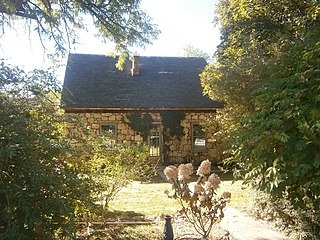
The William Friend Young House at 550 E. Five Hundred N. in Pleasant Grove, Utah, United States, was built during 1885–86. Its exterior walls are soft rock. It was listed on the National Register of Historic Places in 1987.

The Naegle Winery, also known as the Naile House, was built beginning in 1866 in Toquerville, Utah for German immigrant John C. Naegle, who moved to southern Utah after making a small fortune in gold panning in California. Naegle made sacramental wine for The Church of Jesus Christ of Latter-day Saints until wine was discontinued by the church in the late 19th century. The wine industry declined and the winery was converted to can figs, and later to process peaches.
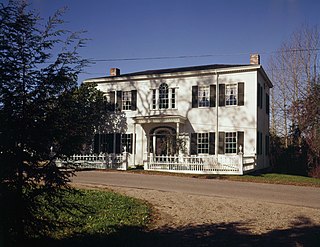
Ruggles House is a historic house museum at 146 Main Street in Columbia Falls, Maine. Built from 1818 to 1820, in Adamesque style, it is noted for its flying staircase and handcrafted woodwork. The house was listed on the National Register of Historic Places in 1970.
The Sibley-Hoyt House is a historic house in Pontiac, Michigan that's center is a frame cabin dating to 1820 making it one of Pontiac's first structures. It was built by Solomon and Sarah Sibley, one of the founders of Pontiac. It is also the county's oldest house.
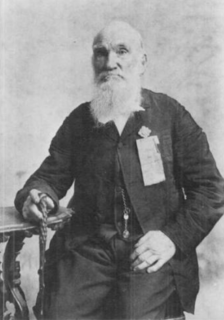
John Steele was an Irish-American pioneer, local politician, physician, and astrologist. Born in Ireland, after converting to the Church of Jesus Christ of Latter-day Saints in Glasgow, Steele and his wife emigrated to Nauvoo, Illinois. Steele joined the Mormon Battalion and traveled to Salt Lake City with the Mormon pioneers. He was one of the founders of Parowan, Utah. Steele also contributed to the development of Iron, Kane, and Washington counties in Utah.
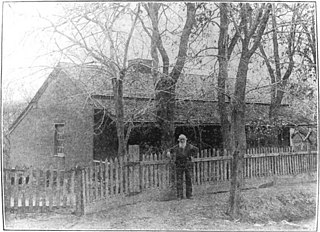
The John Steele House is the historic home of a prominent early resident of Toquerville, Utah. One of the Mormon pioneers, John Steele built the house in 1862 and lived there until his death in 1903, working as an herbal physician and serving in a number of town and county offices. Its floor plan is a rare double-parlor style.






















